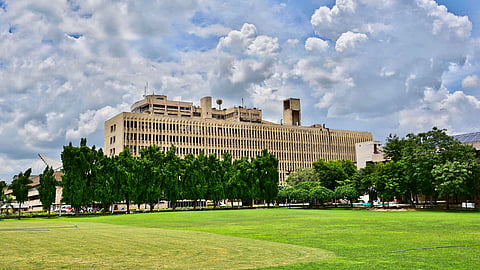
- Destinations
- Experiences
- Stay
- What's new
- Celebrating People
- Responsible Tourism
- CampaignsCampaigns
- SubscribeSubscribe
- Buy Now

Delhi, the bustling capital of India, is a melting pot of diverse cultures and influences. While much attention is given to its ancient Mughal and British colonial heritage, the city also harbours a lesser-known but intriguing connection to the Soviet Union. Here, we delve into the surviving Soviet heritage of Delhi and explore its enduring legacy.
As the decolonisation of colonies started towards the end of the first half of 20th century, newly formed countries had the task of developing a new identity. The brutalist style architecture of Russia, pioneered by Swiss-French architect Le Corbusier, arose as a defining post-colonial response to the imperial architectures within cities.
The term "brutalism" comes from "béton brut," a phrase coined by Le Corbusier, which translates to "raw concrete." The style involves using concrete materials characteristically left exposed, geometry and striking rawness.
What makes it a curious attraction is its debated reputation full of starkly disparate sentiments. While on the one hand, people see it as an "eyesore," a "concrete blob," on the other, they hail it as "iconic," "rare" and "honest."
Brutalism arrived in India at the time of Jawaharlal Nehru and was dedicated towards the construction of public housing, libraries, administrative buildings and educational institutions. It then followed late into the '90s, mastered and crafted by Indian architects like Raj Rewal, Shivnath Prasad, Kuldip Singh, Achyut Kanvinde and Balkrishna Doshi, inspired by Le Corbusier and trained in the style.
Delve into the barebone rawness of the surviving brutalist buildings to visit in Delhi. The geometric aesthetics of the sites make up for instagrammable locations and a lesson in cultural history.
Travellers and Delhiwallahs only have to look around and they will find a plethora of fine examples of brutalist architecture. Combined with the Mughal, Indo-Saracenic and Delhi Sultanate architecture, these four buildings are a must-visit in Delhi.
The Shri Ram Centre for Art and Culture is a renowned theatre located in Mandi House. A gem of brutalist architecture, it was designed by architect Shiv Nath Prasad. With a seating capacity of 403 people in the main hall plus 153 on the balcony, the theatre is most favourable for public events. The cantilevered theatre enhances the interaction between the audience and the stage.
Timings: 9 a.m. to 5 p.m.
How to reach: The Mandi House metro on the Blue line is the closest to Shri Ram Centre. It is located on Safdar Hashmi Marg.
The main building of IIT Delhi, a site of brutalist attraction, was built by J. K. Choudhary. The structure looks like a massive modern human honeycomb. Its unique exposed staircases and utilitarian style of stripped-down architecture match the simplicity and steadiness of mind needed around the campus. The campus admits visitors based on various identity cards. When on campus, visitors can stop at the different food joints for refreshments. Other sites of attraction, such as the Qutub Minar and Hauz Khas, are in close vicinity.
Timings: 9 a.m. to 5:30 p.m.
How to reach: IIT Delhi has a metro station linked to the magenta and yellow lines.
The Tibet House was designed by Shiv Nath Prasad in 1974 at the request of the revered Dalai Lama. The place is a humble block of brutalist brilliance and masterfully conveys Buddhism's monastic lifestyle and simplicity. Visitors can immerse themselves in the vast literature at the library of the place. They can also find things of interest at their bookshop and absorb the heritage exhibited in the museum.
Timings: 9:30 a.m. to 5:30 p.m.
How to reach: Tibet House can be reached by the violet line from the Khan Market metro, which is 1.5 km away.
Designed by Achyut Kanvide, the building of NDDB remains hidden in plain sight in the Safdarjung Enclave area of Delhi. The designer intended to relay a specific modern Indian design unique to the nation's architecture. It is a peculiar amalgamation of cylinders, cubes and other shapes with intermittent plantation on landings. Visitors marvel at the classic brutalist building while on their way to the nearby Sarojini Market for cost-effective shopping or to Humayunpore to treat their tastebuds.
Timings: 9 a.m. to 5 p.m.
How to reach: The nearest metro to NDDB is Green Park metro on the yellow line. It is also accessible from Hauz Khas and R.K. Puram metro.
